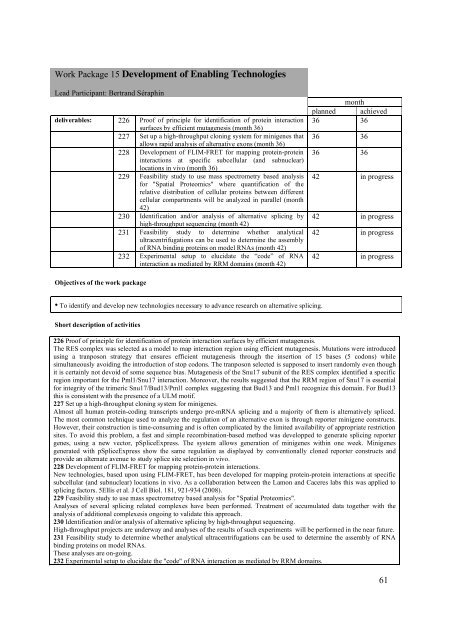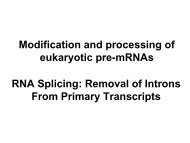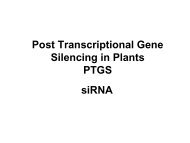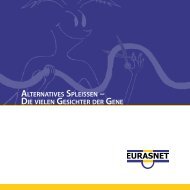You also want an ePaper? Increase the reach of your titles
YUMPU automatically turns print PDFs into web optimized ePapers that Google loves.
Work Package 15 Development of Enabling TechnologiesLead Participant: Bertrand Séraphindeliverables: 226 Proof of principle for identification of protein interactionsurfaces by efficient mutagenesis (month 36)227 Set up a high-throughput cloning system for minigenes thatallows rapid analysis of alternative exons (month 36)228 Development of FLIM-FRET for mapping protein-proteininteractions at specific subcellular (and subnuclear)locations in vivo (month 36)229 Feasibility study to use mass spectrometry based analysisfor "Spatial Proteomics" where quantification of therelative distribution of cellular proteins between differentcellular compartments will be analyzed in parallel (month42)230 Identification and/or analysis of alternative splicing byhigh-throughput sequencing (month 42)231 Feasibility study to determine whether analyticalultracentrifugations can be used to determine the assemblyof RNA binding proteins on model RNAs (month 42)232 Experimental setup to elucidate the “code” of RNAinteraction as mediated by RRM domains (month 42)monthplanned achieved36 3636 3636 3642 in progress42 in progress42 in progress42 in progressObjectives of the work package• To identify and develop new technologies necessary to advance research on alternative splicing.Short description of activities226 Proof of principle for identification of protein interaction surfaces by efficient mutagenesis.The RES complex was selected as a model to map interaction region using efficient mutagenesis. Mutations were introducedusing a tranposon strategy that ensures efficient mutagenesis through the insertion of 15 bases (5 codons) whilesimultaneously avoiding the introduction of stop codons. The tranposon selected is supposed to insert randomly even thoughit is certainly not devoid of some sequence bias. Mutagenesis of the Snu17 subunit of the RES complex identified a specificregion important for the Pml1/Snu17 interaction. Moreover, the results suggested that the RRM region of Snu17 is essentialfor integrity of the trimeric Snu17/Bud13/Pml1 complex suggesting that Bud13 and Pml1 recognize this domain. For Bud13this is consistent with the presence of a ULM motif.227 Set up a high-throughput cloning system for minigenes.Almost all human protein-coding transcripts undergo pre-mRNA splicing and a majority of them is alternatively spliced.The most common technique used to analyze the regulation of an alternative exon is through reporter minigene constructs.However, their construction is time-consuming and is often complicated by the limited availability of appropriate restrictionsites. To avoid this problem, a fast and simple recombination-based method was developped to generate splicing reportergenes, using a new vector, pSpliceExpress. The system allows generation of minigenes within one week. Minigenesgenerated with pSpliceExpress show the same regulation as displayed by conventionally cloned reporter constructs andprovide an alternate avenue to study splice site selection in vivo.228 Development of FLIM-FRET for mapping protein-protein interactions.New technologies, based upon using FLIM-FRET, has been developed for mapping protein-protein interactions at specificsubcellular (and subnuclear) locations in vivo. As a collaboration between the Lamon and Caceres labs this was applied tosplicing factors. 5Ellis et al. J Cell Biol. 181, 921-934 (<strong>2008</strong>).229 Feasibility study to use mass spectrometrey based analysis for "Spatial Proteomics".Analyses of several splicing related complexes have been performed. Treatment of accumulated data together with theanalysis of additional complexesis ongoing to validate this approach.230 Identification and/or analysis of alternative splicing by high-throughput sequencing.High-throughput projects are underway and analyses of the results of such experiments will be performed in the near future.231 Feasibility study to determine whether analytical ultracentrifugations can be used to determine the assembly of RNAbinding proteins on model RNAs.These analyses are on-going.232 Experimental setup to elucidate the "code" of RNA interaction as mediated by RRM domains.61







